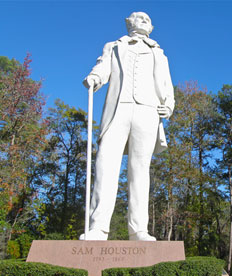
Source: Sam Houston, 1793-1863, Roy Luck, Flickr
In this section, you will investigate scale factors and how they relate to rates of change. You will also represent rates of changes in tables and graphs, and look for patterns.

Source: Sam Houston, 1793-1863, Roy Luck, Flickr
In 1994, A Tribute to Courage, a 67-foot tall statue of Sam Houston, was dedicated just south of Huntsville, Texas. The statue was built to honor the first president of the Republic of Texas, and the namesake of Texas’s largest city, Houston.
In real life, Sam Houston was 6 feet, 6 inches, or 6.5 feet, tall. The statue is a scaled version of what we know about how Sam Houston looked from pictures and other historical artifacts.
Use the interactive below to determine the actual dimensions of Sam Houston based on what can be measured from the statue. Use the scale factor 6.5 over 67 6.5 67 to determine the actual dimensions from the dimensions of the statue.
![]() Calculate the actual dimensions of Sam Houston from the dimensions on the statue. Round your answers to the nearest hundredth of a foot. Drag the tile that best represents the actual dimension next to the part of the statue with a given measurement. You may not use all of the tiles.
Calculate the actual dimensions of Sam Houston from the dimensions on the statue. Round your answers to the nearest hundredth of a foot. Drag the tile that best represents the actual dimension next to the part of the statue with a given measurement. You may not use all of the tiles.
Let’s represent this information in a table, and look more closely at the rate of change in the table.
![]() In the table below, click on the question mark to see the rate of change from one row to the next. Then, use the completed table to answer the questions that follow.
In the table below, click on the question mark to see the rate of change from one row to the next. Then, use the completed table to answer the questions that follow.
Interactive popup. Assistance may be required.
0.94 over 9.7 0.94 9.7 ≈ 0.097 0.61 over 6.3 0.61 6.3 ≈ 0.097 0.9 over 9.3 0.9 9.3 ≈ 0.097 0.24 over 2.5 0.24 2.5 ≈ 0.096
Interactive popup. Assistance may be required.
The ratios are equal, or nearly equal.
Interactive popup. Assistance may be required.
The data has a constant rate of change.
Interactive popup. Assistance may be required.
The scale factor used to relate the actual measurements to the dimensions of the statue was 6.5 over 67 6.5 67 ≈ 0.097, which is the same as the ratios of the successive differences in the table.
Now that you have the dimensions of parts of both the statue and the actual measurements for Sam Houston, you can represent those number pairs as points on a coordinate plane.
![]() Click on the ordered pair below, and drag it to the correct location on the coordinate plane provided. Once you have correctly plotted all points, the trend line will appear at the best place to connect most of the points. If necessary, you can use the Reset button to reset the graph.
Click on the ordered pair below, and drag it to the correct location on the coordinate plane provided. Once you have correctly plotted all points, the trend line will appear at the best place to connect most of the points. If necessary, you can use the Reset button to reset the graph.
Use the information from the interactive to answer the following questions.
Interactive popup. Assistance may be required.
The scale factor used to relate the actual measurements to the dimensions of the statue was 6.5 over 67 6.5 67 ≈ 0.097, which is the same as the rate of change represented by the steepness of the line and the coefficient of x in the graph.
For data with a constant rate of change, how does the scale factor relate to the rate of change in a table or a graph?

Source: Statue of Liberty Frontal 2, Daniel Schwen, Wikimedia Commons
A replica of the Statue of Liberty is on the grounds of the state capitol in Austin, Texas. The replica has a height of approximately 5 meters, and the actual Statue of Liberty in New York, New York, has a height of approximately 45 meters.
Interactive popup. Assistance may be required.
Determine the ratio of the height of the replica to the height of the original statue.
Interactive popup. Assistance may be required.
How does the scale factor relate to the steepness of the line in each graph?